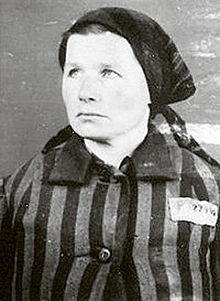- Maria Kotarba
-
Main article: Polish Righteous Among the Nations
Maria Kotarba (b. 4 September 1907, near Nowy Sącz — d. 30 December 1956) was a courier in the Polish resistance movement, smuggling clandestine messages and supplies among the local partisan groups. She was arrested, tortured and interrogated by the Gestapo as a political prisoner before being imprisoned in Tarnów and then deported to Auschwitz on January 6, 1943. Maria Kotarba was recognised as Righteous Among the Nations by Yad Vashem on September 18, 2005 for risking her life to save the lives of Jewish prisoners in two concentration camps.[1][2]
After the Nazi German invasion of Poland in September 1939, Maria Kotarba, a Catholic, witnessed the extermination of her Jewish neighbours near Gorlice, where she lived, and vowed to aid any Jew she could.[3] Arriving at Auschwitz in the winter of 1943 she was allocated the prisoner number 27995, and after a range of camp duties, in the middle of 1943 was assigned to Kommando Gartnerei, the Gardening Commando labour squad. She worked in the confiscated gardens around the nearby village of Rajsko, involved in the cultivation of vegetables and other ancillary labours.[2] By the summer of 1943, the resistance movement in the camp became organised and brought Kotarba into their ranks. Her reputation as a skilled courier traveled with her from Tarnów. Maria was involved in smuggling food, medicine and messages from the outside resistance groups into the camp.[2]
Friendships
In the camp, Kotarba met Lena Mankowska (née Bankier), deported to the camp from the Jewish Ghetto in Białystok. At registration, the prisoner-clerks registered Lena as a Polish political prisoner on account of her non-Jewish looks. The two women developed a deep and lasting friendship.[2] Kotarba was aware of the other woman's perilous position and did all she could to help her as well as her sister, Guta, who arrived in Auschwitz from the concentration camp at Lublin-Majdanek with her friend Henia Trysk. Lena Mankowska referred to Kotarba as the "Mom of Auschwitz" (Polish: Mateczka).[4] As a courier, Kotarba delivered medicine for the prisoner-doctors and brought in other supplies, which they shared. She used her resistance contacts to have Lena Mankowska allocated to lighter duties when she fell sick, and cooked soup for her on a small stove in her block.[5]
In January 1945, the SS evacuated the camp through Birkenau deeper into Nazi Germany. The two women arrived separately at Ravensbrück in open coal wagons. Kotarba found her Jewish friend almost dead in the snow and carried her to her own barracks. [6] In February 1945, the SS again moved the prisoners to the Neustadt-Glewe sub-camp, where the Red Army liberated the women in May 1945. After liberation, the two friends parted. Maria Kotarba returned to her home in Poland, remained single and died in 1956, aged 49, never having returned to the health she enjoyed before the war. She was buried in Owczary.
Lena Mankowska married and settled in Great Britain. In 1997, Lena made an unsuccessful attempt to get Maria, her "Angel of Auschwitz",[2][7] recognised as one of the Righteous Among the Nations by Yad Vashem in Jerusalem. Eight years later James Foucar successfully resubmitted her testimony, which was approved by Yad Vashem on December 8, 2005 based on Kotarba's qualifications for inclusion.[5]
References
- ^ Yad Vashem Remembrance Authority, Maria Kotarba
- ^ a b c d e The State Museum Auschwitz-Birkenau, Poland. James Foucar, Angel of Auschwitz honoured 2006 (PDF 109.5 KB) at www.auschwitz.org.pl
- ^ McDonough, Chris "Maria Kotarba, Poland" International Raoul Wallenberg Foundation
- ^ (Polish) Ireneusz Dańko, Pośmiertne honory dla "Mateczki z Auschwitz", (Posthumous Honors for the "Mom of Auschwitz") October 25, 2006, Gazeta.pl, Kraków
- ^ a b James Foucar, homepage, Maria Kotarba: Righteous Among the Nations
- ^ McDonough, Chris "Maria Kotarba, Poland" International Raoul Wallenberg Foundation
- ^ Daily Express, London, "My Angel of Auschwitz" October 26, 2005, p. 31
Resources
- Yad Vashem Remembrance Authority, Jerusalem, Maria Kotarba, Righteous Among the Nations
- The State Museum Auschwitz-Birkenau, Poland, "Angel of Auschwitz honoured" 2006 (PDF 109.5 KB) at the State Museum homepage
Overview Main article • The Holocaust • The Holocaust in Poland • Holocaust victims • List of individuals and groups assisting Jews • Righteousness • Seven Laws of Noah • Yad Vashem
Famous individuals Irena Adamowicz • Archbishop Damaskinos of Athens • Feng-Shan Ho • Jan Karski • Carl Lutz • Tadeusz Pankiewicz • Oskar Schindler • Irena Sendler · Henryk Sławik • Raoul Wallenberg • Rudolf WeiglNations and groups Related article by country: Rescue of Jews by Poles during the Holocaust  Polish Underground State
Polish Underground StateAuthorities Political
organizationsMajor Minor Camp of National Unity · Democratic Party · Jewish Labor Bund · Hashomer Hatzair · Betar (Zionist youth)Opposition Military
organizationsArmia Krajowa (AK) · Service for Poland's Victory · Armed Struggle (ZWZ) · Szare Szeregi · National Security CorpsMostly integrated
with ZWZ-AKPartially integrated
with ZWZ-AKNon-integrated Opposition Related topics Categories:- 1907 births
- 1956 deaths
- Polish Righteous Among the Nations
- Auschwitz concentration camp survivors
- Ravensbrück concentration camp survivors
- Polish women in war
- People from Nowy Sącz
Wikimedia Foundation. 2010.



